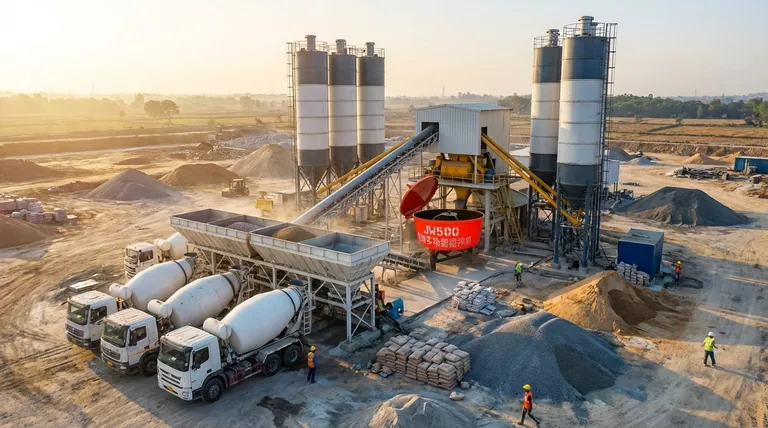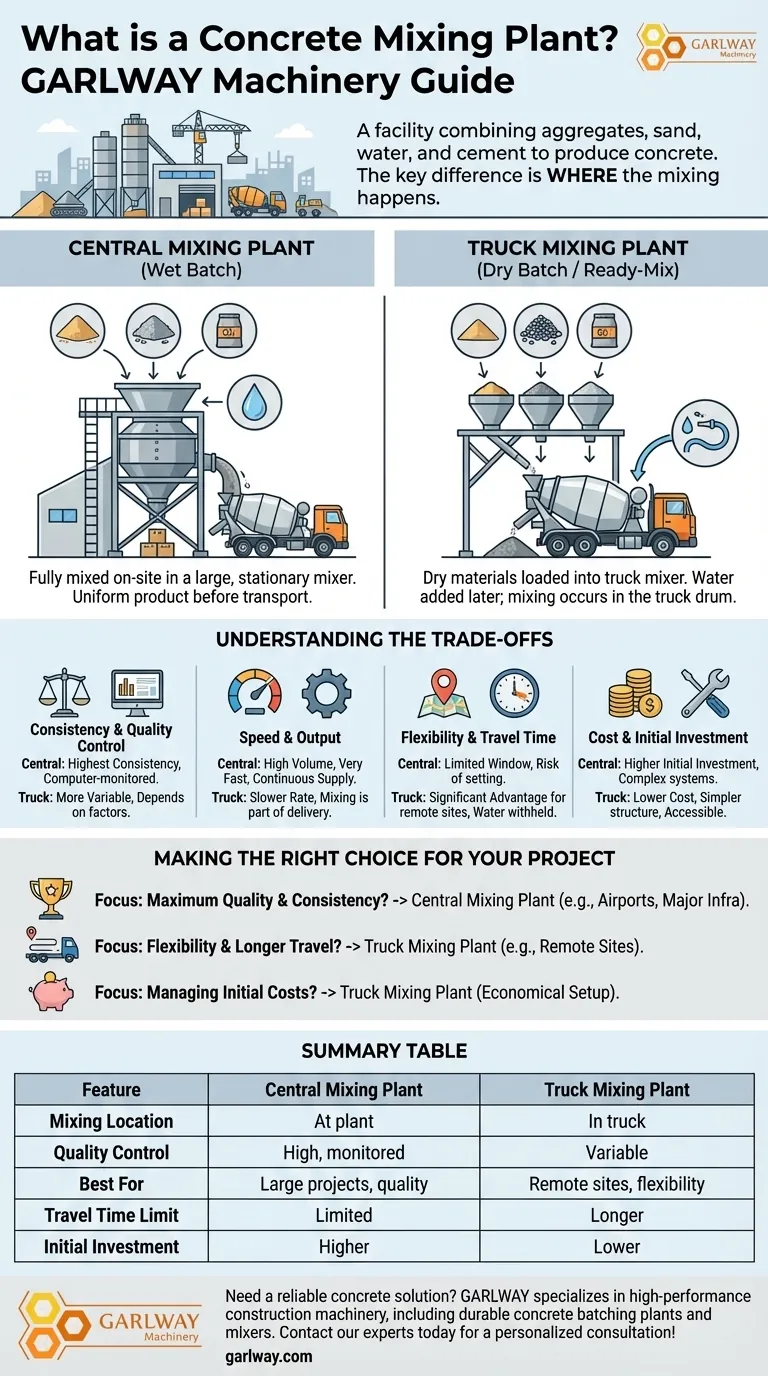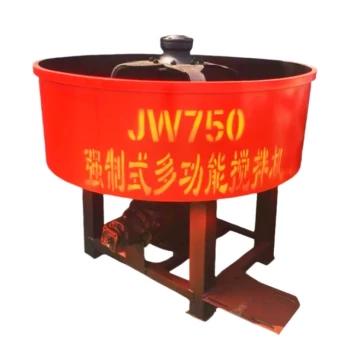In the world of construction, a mixing plant is a facility designed to combine specific quantities of aggregates, sand, water, and cement to produce concrete. The primary distinction between plants lies in where the final mixing occurs. In a central mixing plant, concrete is fully mixed at the plant before being transported, whereas in a truck mixing plant, the dry ingredients are loaded into a truck mixer where water is added later.
The fundamental choice in concrete production is not about the ingredients, but about the location of the mix. This single decision—mixing at a central plant versus inside the delivery truck—dictates the project's trade-offs between quality control, speed, and logistical flexibility.

The Two Core Types of Concrete Mixing Plants
Understanding the operational difference between the two main plant types is essential for appreciating their distinct advantages and applications.
Central Mixing Plants (Wet Batch)
A central mixing plant uses a large, stationary mixer to combine all ingredients, including water, on-site.
The result is concrete that is fully mixed and uniform before it ever leaves the plant. This finished product is then discharged into an agitator truck designed to keep the concrete from setting during transport.
Truck Mixing Plants (Dry Batch / Ready-Mix)
A truck mixing plant, often called a dry batch or ready-mix plant, operates differently.
It measures and places all the unmixed dry materials—cement, sand, and aggregates—directly into a truck mixer. Water is then added to the truck's drum either just before departure, during transit, or upon arrival at the construction site, with the truck's rotating drum performing the mixing.
Understanding the Trade-offs
Neither system is inherently superior; they are simply suited for different needs. The right choice depends on balancing quality, cost, and project logistics.
Consistency and Quality Control
Central mixing plants offer the highest level of consistency. Mixing is performed in a controlled, computer-monitored environment, ensuring every batch meets precise specifications.
The quality from a truck mixing operation can be more variable, as it depends on factors like travel time, the condition of the truck's drum, and the accuracy of adding water on-site.
Speed and Output
Because the mixing is done in a large, efficient stationary unit, central mix plants can produce high volumes of ready-to-pour concrete very quickly. This makes them ideal for large-scale projects requiring a continuous supply.
With truck mixing, the mixing process itself is part of the delivery timeline, which can slow down the rate of supply compared to a central plant's output.
Flexibility and Travel Time
Truck mixing provides a significant advantage for projects that are far from the plant. By withholding the water until the truck is near the site, you eliminate the risk of the concrete hardening (setting) prematurely during a long journey.
Concrete from a central mix plant has a limited window for transport and use before it begins to lose workability.
Cost and Initial Investment
Central mix plants are more complex systems that require more advanced and costly equipment. This higher initial investment is balanced by their efficiency and quality output.
Dry batch plants are structurally simpler and less expensive to build and operate, making them a more accessible option for many suppliers.
Making the Right Choice for Your Project
Selecting the right type of plant depends entirely on your project's specific demands for quality, volume, and logistics.
- If your primary focus is maximum quality and consistency: A central mixing plant is the clear choice for projects like airport paving or major infrastructure where batch-to-batch uniformity is non-negotiable.
- If your primary focus is flexibility and longer travel distances: A truck mixing (dry batch) plant provides the necessary control over timing, ensuring the concrete is fresh upon arrival at a remote job site.
- If your primary focus is managing initial investment costs: A dry batch plant offers a more economical setup while still providing reliable concrete production for a wide range of applications.
Understanding this core distinction empowers you to align your concrete supply with your project's unique requirements for precision and efficiency.
Summary Table:
| Feature | Central Mixing Plant | Truck Mixing Plant (Dry Batch) |
|---|---|---|
| Mixing Location | At the plant (wet batch) | In the truck drum |
| Quality Control | High consistency, computer-monitored | Variable, depends on transit & water addition |
| Best For | Large projects, high volume, top quality | Remote sites, flexibility, cost-efficiency |
| Travel Time Limit | Limited (concrete can set) | Longer (water added later) |
| Initial Investment | Higher | Lower |
Need a reliable concrete solution for your next project? GARLWAY specializes in high-performance construction machinery, including durable concrete batching plants, mixers, and winches for contractors and construction companies worldwide. Let us help you select the perfect equipment to ensure your project's success, balancing quality, speed, and budget. Contact our experts today for a personalized consultation!
Visual Guide

Related Products
- Portable Concrete Mixer Machine Equipment for Mixing Concrete
- HZS35 Small Cement Concrete Mixing Batch Plant
- HZS75 Concrete Batching Plant Cement Mixer Price Concrete Mixer Bunnings Mixing Plant
- HZS180 Ready Mix Concrete Plant for Foundations with Sand and Cement
- Commercial Construction Mixer Machine for Soil Cement Mixing Concrete
People Also Ask
- How much does a portable concrete mixer hold? A Guide to Choosing the Right Capacity
- How much does a batching plant cost? Uncover the True Investment for Your Project
- What are the disadvantages of concrete mixers? Hidden Costs & Quality Risks Revealed
- What are the disadvantages of ready mixed concrete? Navigate Logistical & Cost Risks
- How much concrete can you pour with a portable mixer? Find the Perfect Fit for Your Project



















